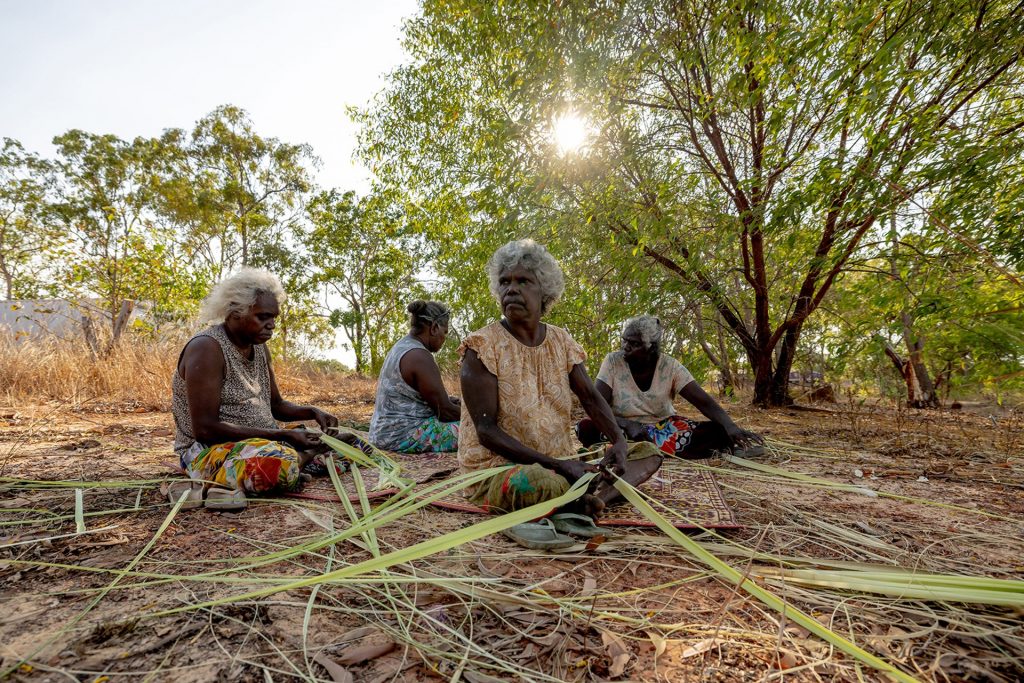
Michelle Baker, Freda Ali, Freda Wayartja Ali and Cecilia Baker, four of the ten principal weavers of Mun-dirra at the National Gallery of Australia, prepare pandanus for dyeing – Photo Renae Saxby, Courtesy National Gallery of Victoria and Maningrida Arts & Culture.
What is the cultural significance of First Nations weaving?
Weaving is one of the most complex and sophisticated examples of First Nations technology and culture. It produces objects of beauty, and the process itself has deep cultural significance. Weaving is a way to share knowledge, connect to people and country, invite mindfulness, and much more.
Woven objects are as diverse as the First Nations weavers that create them. Each work is an object of significance that forms a visible tie between the weaver, country and their ancestors.
The weaving begins by gathering and preparing local resources such as reeds, bark and plants. These are woven to form a pattern to create intricate objects like baskets, bowls, rope and nets.

ADELAIDE, AUSTRALIA: An Indigenous weaving workshop takes place in The Precinct Village an AFLW match. Credit: Kelly Barnes/AFL Photos/via Getty Images.
Weaving connects people
Weaving is not just about learning the stitches and the process.
Yes – men weave too
For me, weaving, predominantly rope weaving, plays a big part, especially with our men’s tools.Luke Russell, Cultural Knowledge Holder
He uses sophisticated weaving techniques to secure his canoes’ ends or bind tools with woven rope.
From early childhood to teenage years, boys traditionally spent time with their matriarchal hierarchy and learned to weave alongside girls.

Pandanus palm fibre mats – Credit: Richard I’Anson/Getty Images.
Weaving as a moving meditation
Cherie Johnson uses weaving to diarise her thoughts visually. She practices mindfulness by weaving with intent and pouring her thoughts into the object.
“That’s how our community would process things,” she says.
Stylistic differences
Plant resources such as grasses and barks differ across the country, so weaving differs stylistically from region to region.
But the weavers bring their own flair and signature style to their work.
One way is to use local pigments from flowers, barks, saps or roots.
Typically somebody with a trained eye can pick the region and sometimes even the artist based on the pigment, the style, the stitch and the materials.Cherie Johnson, artist and educator
Sometimes, you can identify the artist by looking at the base of the weaving.
Artist Nephi Denham is a Girramay Traditional Owner from the Cardwell area in North Queensland. His uncle taught him to weave.
“Many of our artists including myself, we start [the weaving] off differently,” Mr Denham says.
“That’s how you can tell from the base of it whether it’s left or right-hand weaving. So you can really tell who’s made what.”

Woman weaving basket with pandanus palm fibre – Credit: Richard I’Anson/Getty Images.
Can we get involved?
Cassie Leatham is a multidisciplinary artist and master weaver from the Taungurung people of the Kulin nation in Victoria. She facilitates First Nations-led workshops that are open to non-Indigenous people.
Participants are urged to listen deeply to promote a greater understanding of where First Nations weavers come from and the connection to their ancestors.
“It’s important that they know these workshops should be First Nations-led, and they should take away the importance of cultural intellectual property of our knowledge here in Australia,” Ms Leatham says.
It’s about respecting protocol. We can all share what we’ve learnt, but we shouldn’t profit from it – and we must always acknowledge our First Nations teachers.
Mainstream visibility
Weavings are exhibited and sold in both major and small galleries across Australia as commissioned works in private and public spaces and even on fashion runways.
It’s important that galleries showcase the diversity of First Nations cultures and environments.
“The mainstream with weaving is actually a visual insight into the past, which is now the present, and all of us weavers are continuing for our future generations,” Cassie Leatham says.
SOURCE: SBS AUSTRALIA
Published by SBS on 13 February 2024
Available in various languages
>> Click here to listen to the original podcast